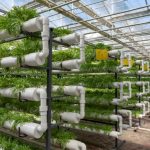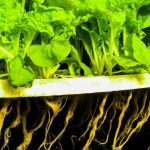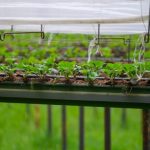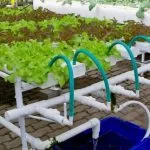Deep Flow Technique hydroponics, or DFT, is a type of hydroponic system that is gaining popularity among gardeners and farmers. This technique is also known as the “recirculating raft” method (a hybrid of deep water culture and nutrient film technique) or “raceway” system and is ideal for growing leafy greens, herbs, and other small plants. Unlike some other hydroponic systems, DFT hydroponics does not require any growing medium, which makes it a cost-effective and efficient way to grow plants.
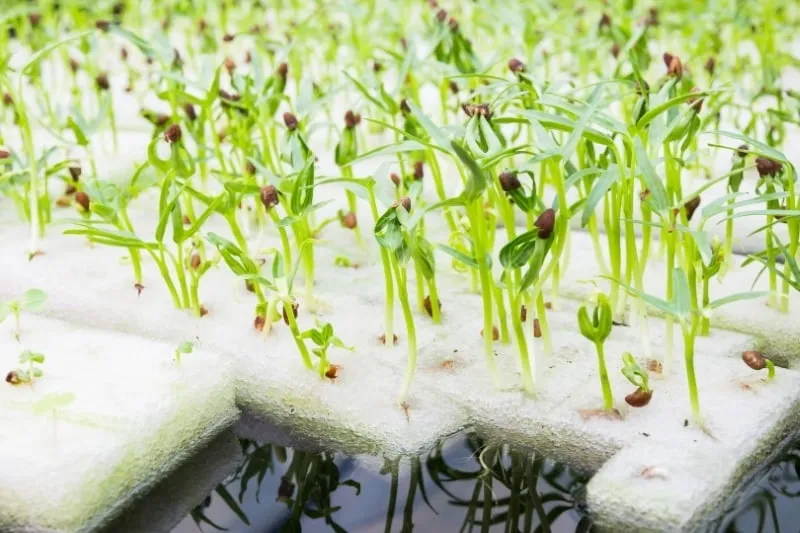
The concept behind DFT hydroponics is simple. Plants are grown in a shallow trough or channel that is filled with nutrient-rich water. A floating platform, usually made of Styrofoam, supports the plants and keeps them above the water. The roots of the plants dangle in the water, absorbing the nutrients they need to grow. The water is continuously circulated, which provides a constant supply of nutrients to the plants. This technique allows plants to grow faster and healthier than traditional soil-based methods, as they have easy access to nutrients and oxygen.
- Understanding Deep Flow Technique Hydroponics
- What is the Difference Between NFT and DFT Hydroponics?
- What is the Difference Between DFT and DWC Hydroponics?
- Disadvantages of Deep Flow Technique
- Advantages of Deep Flow Technique
- Setting Up Your Deep Flow Technique Hydroponics System
- Choosing the Right Plants for Your DFT System
- Maintaining Water Quality in Deep Flow Technique Hydroponics
- Monitoring and Managing Plant Health
- Tips and Tricks for Success in DFT
- Scaling Up: Expanding Your Deep Flow Technique Hydroponics Setup
- Deep Flow Technique Hydroponics for Beginners
Understanding Deep Flow Technique Hydroponics
To comprehend the intricacies of Deep Flow Technique Hydroponics, let’s delve into its key components. Firstly, this system consists of a shallow channel or tray, typically made of plastic or another durable material, that provides a stable environment for plant growth.
Additionally, an efficient water circulation system is implemented to maintain a constant flow of water, ensuring the plant roots are adequately nourished. This water enriched with dissolved nutrients and oxygen is fed into the tray from a separate reservoir via a water pump and water line. An air pump outside the reservoir is connected to air stones inside to ensure a rich supply of oxygen in the water.
Water plays a vital role in this hydroponic system, serving as a vehicle for delivering essential nutrients to the plants. As the water flows continuously through the channel, it carries nutrients and oxygen, enabling the plants to absorb them efficiently. This method eliminates the need for soil, as plants can thrive solely on the water and nutrient solution.
What is the Difference Between NFT and DFT Hydroponics?
While Deep Flow Technique hydroponics may bear some resemblance to Nutrient Film Technique (NFT), there are significant differences between the two. In DFT, the water level is kept at a deeper depth, ensuring that the roots are consistently submerged. On the other hand, hydroponic NFT involves a thin film of water flowing over the bottom part of the roots, with the rest exposed to air. This distinction highlights the unique characteristics of the Deep Flow Technique, allowing for more substantial root growth and nutrient absorption, while lowering the risk of them drying out completely in case of a water supply failure.
What is the Difference Between DFT and DWC Hydroponics?
Deep Flow Technique hydroponics is often compared to Deep Water Culture (DWC) due to their similar names. However, the key distinction lies in the way the roots interact with the water. In hydroponic DWC, the roots are directly suspended in a nutrient solution in an oxygen-rich water reservoir, allowing for maximum exposure to both water and oxygen. In DFT, the roots are partially submerged in a tray with a continuous flow of recirculated water, enabling efficient nutrient uptake while also promoting oxygenation. The combination of water flow and oxygen availability in DFT hydroponics contributes to vigorous plant growth and optimized nutrient absorption.
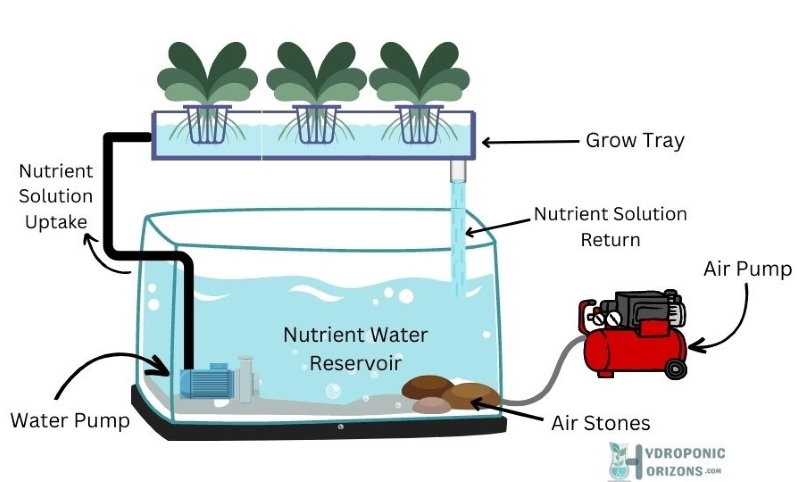
Disadvantages of Deep Flow Technique
As with any cultivation method, a deep flow technique hydroponic system has its limitations. One significant disadvantage is the potential for waterborne diseases and pathogens to affect the plants. The continuous flow of water can create a favorable environment for harmful organisms, requiring diligent monitoring and disease prevention measures.
Additionally, you may be tempted to use longer trays with fewer water inlets and outlets. However, doing this risks uneven distribution of nutrients, as the water inlet is closer to some plants than others. Therefore, it’s important to use short trays with just a few plants grown in each. This way, the initial setup of the system may be more complex compared to other hydroponic methods, necessitating careful planning and attention to detail.
Advantages of Deep Flow Technique
Despite its drawbacks, DFT offers numerous advantages that make it an attractive choice for plant cultivation. One notable advantage is the increased availability of nutrients to the plants. As the roots are submerged in a continuously flowing stream of nutrient-rich water, they have constant access to the essential elements needed for growth. This results in accelerated plant development, improved nutrient uptake efficiency, and ultimately higher yields.
DFT is quite a safe hydroponic system. There’s less risk of root dehydration or inadequate nutrient flow if there are power outages or if the water pump fails compared to the NFT or ebb and flow methods, as the tray of water will hold enough water until the pump is replaced with a backup, which doesn’t have to be done immediately. There’s also no risk of channel blockages like in NFT.
Additionally, the continuous water flow helps prevent the accumulation of salts around the roots, reducing the risk of nutrient imbalances and root damage.
Another way that the optimal growing conditions for the crops are maintained is that this technique is helpful in keeping the system’s temperature stable for the plants.
Finally, it may appear hard to cultivate leafy crops or leafy plants in some environments, but the deep flow technique of hydroponics farming makes it feasible.

Setting Up Your Deep Flow Technique Hydroponics System
When embarking on your DFT hydroponics journey, several key considerations should be made during the setup process. Firstly, selecting the appropriate container tray is essential. Opt for a sturdy, food-grade plastic container that can accommodate the desired number of plants and provide sufficient space for root growth.
Next, choosing the right growing medium is crucial. While Deep Flow Technique Hydroponics eliminates the need for soil, a suitable growing medium is still necessary to support the plants and maintain root stability. Common options include expanded clay pellets, coconut coir, or rockwool cubes. Consider the characteristics of each medium and select the one that best suits your plant varieties and preferences.
To ensure proper water circulation, installing a reliable plumbing system is vital. This involves setting up a water pump to facilitate the continuous flow of water through the channel or tray. Position the pump strategically to allow for efficient water distribution, minimizing stagnant areas and promoting uniform nutrient uptake by the plants.
To ensure an adequate oxygen supply to the roots, you will need an air pump that’s connected to air stones placed inside the reservoir. While plant roots are not fully submerged in water, they still need a little extra oxygen to prevent them from drowning.
Choosing the Right Plants for Your DFT System
Certain plant varieties are particularly well-suited for DFT due to their adaptability to water-based cultivation. Leafy greens such as lettuce, kale, and spinach thrive in this system, as do herbs like basil, parsley, and mint. Additionally, vining plants such as tomatoes, cucumbers, and beans can also be successfully grown using this method.
Considerations for selecting plants go beyond variety. Pay attention to the size and nutrient requirements of the plants. Ensure that your chosen plants have ample space to spread their roots and grow without overcrowding the system. Additionally, be mindful of their nutrient demands, adjusting the nutrient solution accordingly to maintain a balanced and optimal growing environment.
Maintaining Water Quality in Deep Flow Technique Hydroponics
Water quality is of paramount importance in Deep Flow Technique Hydroponics, as it directly impacts plant health and nutrient uptake. Monitoring and adjusting the pH levels of the water is crucial to maintain an optimal range for nutrient absorption. Regularly test the pH using a reliable meter and make necessary adjustments using pH up or down solutions.
In addition to pH, managing nutrient levels is vital for preventing deficiencies or toxicities. Regularly measure the electrical conductivity (EC) of the nutrient solution to ensure it falls within the appropriate range for your plants. Adjust the nutrient solution strength accordingly to provide a balanced and well-rounded blend of essential elements.
To maintain water clarity and prevent algae growth, consider implementing preventive measures. Lightproofing the system by covering the channels or trays can inhibit algae growth by blocking light exposure. Additionally, introducing beneficial bacteria or adding hydrogen peroxide in small quantities can help control algae while ensuring a healthy environment for the plants.
Monitoring and Managing Plant Health
Tips for ensuring successful plant growth and productivity include regular monitoring of plant health, adjusting environmental conditions as needed, and providing adequate lighting. Maintaining optimal temperature and humidity levels, coupled with proper ventilation, will contribute to robust plant growth and bountiful harvests.
As with any cultivation method, it is essential to be vigilant in monitoring and managing plant health in the Deep Flow Technique. Recognizing common plant diseases such as root rot, powdery mildew, and fungal infections is crucial to address issues promptly. Implement preventive measures such as maintaining proper air circulation, avoiding overwatering, and ensuring the cleanliness of the system and tools.
Additionally, consider implementing integrated pest management strategies to control pests that may affect your plants. Regularly inspect the leaves, stems, and roots for signs of pests, and take appropriate action using organic pest control methods when necessary.
Tips and Tricks for Success in DFT
Fine-tuning your Deep Flow Technique hydroponics system can enhance your overall success and productivity. Effective techniques for managing water flow and nutrient distribution include using flow control valves to adjust water speed, ensuring even distribution across all plants. Regularly check and clean the system to prevent clogging and maintain optimal water flow.
Enhancing productivity and efficiency can be achieved through expert tips such as implementing a timed lighting system to provide the appropriate amount of light for your plants. Consider using high-quality LED grow lights that emit the specific wavelengths necessary for photosynthesis.
Additionally, optimizing environmental conditions by controlling temperature, humidity, and airflow can greatly influence plant growth and overall success. Investing in a quality thermometer, hygrometer, and ventilation system will help you maintain the ideal conditions for your plants’ well-being.
Scaling Up: Expanding Your Deep Flow Technique Hydroponics Setup
Once you have gained confidence and experience with Deep Flow Technique Hydroponics, you may consider scaling up your hydroponic garden. Expanding your setup involves several steps, starting with evaluating the available space and resources. Determine the appropriate size and layout for your expanded system, considering factors such as the number of plants you intend to grow and the overall efficiency of the operation.
Considerations for larger-scale hydroponic farming operations include the availability of a reliable water source, adequate lighting for the increased number of plants, and the feasibility of managing the expanded system efficiently. Investing in automation and advanced monitoring systems can streamline operations and facilitate easier management of multiple channels or trays.
When managing multiple DFT hydroponics systems, it is essential to maintain consistency in nutrient solution composition, water quality, and environmental conditions. Regular monitoring and synchronization across all systems will ensure uniform plant growth and optimal yields.
Deep Flow Technique Hydroponics for Beginners
For beginners, Deep Flow Technique hydroponics offers an exciting and rewarding entry into the world of hydroponic gardening. Simplifying the setup process is key to making it accessible to new growers. Begin by starting small with a single channel or tray and gradually expand as you gain experience and confidence.
Key tips for success and confidence in Deep Flow Technique Hydroponics include thorough research, understanding the needs of your chosen plant varieties, and starting with reliable and proven systems and equipment. Seek guidance from experienced growers or join online communities to learn from their experiences and gain valuable insights.
In conclusion, Deep Flow Technique Hydroponics is a game-changer in plant cultivation, revolutionizing the way we grow plants by providing a nutrient-rich, water-based system. By understanding its key components, advantages, and considerations, you can embark on a successful journey of growing high-yield, healthy plants in a controlled environment. With dedication, knowledge, and a passion for plants, you can unlock the potential of Deep Flow Technique Hydroponics and enjoy the rewards of a thriving hydroponic garden.

